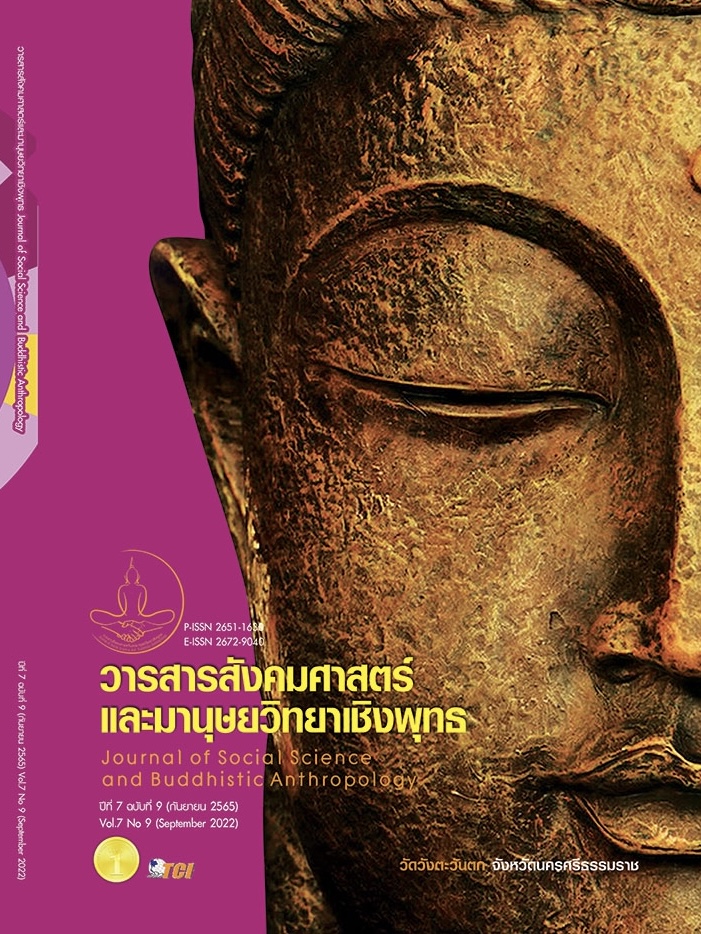THE EXTENSION MODEL OF SOUR TAMARIND PRODUCTION FOR BUSINESS
Keywords:
Model, Extension, Sour Tamarind Production, CommercialAbstract
The Objectives of this research article were to 1) sour tamarind production for commercial of the farmers 2) cost and return on investment in sour tamarind cultivation 3) the extension gained and need for sour tamarind production of the farmers 4) the development of model and 5) the evaluation of model. This mixed methods research. The sample groups 1) 193 sour tamarind growers 2) 11 representatives who were related to the extension in commercial sour tamarind production 3) 9 experts. The interview questions were used. Data were analyzed by using descriptive analysis, t - test, multiple regression analysis, factor analysis and content analysis. The results showed that 1) most of the farmers production with the average farm size for tamarind production was 7.06 Rai. The average age of sour tamarind tree was 10.09 years. Most of the farmers grew tamarind cultivar Kradan by using grafted tamarind tree with 8 x 8 m spacing. 2) The variable cost regarding harvest was rather high because of no appropriate technology in substitution of human labor. The average cost of production was 11,023.83baht/rai. The average income from selling ripe and unripe pods, preserved tamarind in syrup and tamarind paste was 24,364.03 baht/rai. The analysis on the possibility of investment in sour tamarind production revealed that the net present value was 13,340.20 baht, benefit/cost ratio was 2.21 and the rate of return on investment was 121.01%. 3) For the extension needs for agro - commercial sour tamarind production, the farmers wanted to gain the additional knowledge at the highest level in every aspect of sour tamarind production from personal, publication media and electronic media. The level of extension method needed for sour tamarind production was a training workshop method.4) The extension model for the process of SMCMR Model by using results based on management concept. 5) For model evaluation results, the opinions from related parties were at the highest level on the possibility for the adoption into practice, the appropriateness, and the adoption for actual benefits.
References
กรมส่งเสริมการเกษตร. (2559). ระบบสารสนเทศการผลิตทางด้านเกษตร. เรียกใช้เมื่อ 5 ธันวาคม 2560 จาก http://production.doae.go.th/
การปลูกมะขามเปรี้ยว. (2560). การปลูกมะขามเปรี้ยวยักษ์. เรียกใช้เมื่อ 5 ธันวาคม 2560 จาก https://www.kasetorganic.com/
ณัฐณิชา อินจำปา. (2560). ศึกษากลยุทธ์การตลาดเพื่อการเพิ่มมูลค่ามะขามหวานจังหวัดเพชรบูรณ์. การประชุมวิชาการระดับชาติ มหาวิทยาลัยราชภัฏเพชรบูรณ์, 4(2560), 174-181.
ณิชาบูล อินทรพุฒิ. (2554). ศึกษาความเป็นไปได้ในการลงทุนปลูกมะขามหวานในเขตอำเภอเมือง จังหวัดเพชรบูรณ์. ใน วิทยานิพนธ์เศรษฐศาสตรมหาบัณฑิต สาขาวิชาเศรษฐศาสตร์ธุรกิจ . มหาวิทยาลัยหอการค้าไทย.
ตลาดสี่มุมเมือง. (2560). ราคาสินค้า มะขามเปียกแกะ. เรียกใช้เมื่อ 10 มีนาคม 2561 จาก http://www.taladsimummuang.com/dmma/Portals/PriceListItem. aspx?id=040004010
ทวีศักดิ์ ชัยเรืองยศ. (2562). เทคโนโลยีชาวบ้าน สวนมะขามเปรี้ยวยักษ์สร้างเงิน. เรียกใช้เมื่อ 8 กุมภาพันธ์ 2565 จาก https://www.technologychaoban.com/agri culturaltechnology/article_89520
วศิน เสริมสุธีอนุวัฒน์ และคณะ. (2565). มูลค่าส่งออกมะขามเปียก. เรียกใช้เมื่อ 8 กุมภาพันธ์ 2565 จาก https://sites.google.com/site/artistiara/ makham/makham - phuch - sersthkic/mulkha - sng - xxk - makham - peiyk
ศิระกาญจณ์ อะนันเอื้อ. (2561). โมเดลการส่งเสริมการเรียนรู้ด้านการเกษตรสำหรับเยาวชน. Veridian Journal, Silpakorn University, ฉบับภาษาไทยสาขามนุษยศาสตรสังคมศาสตร์และศิลปะ, 11(3), 2531-2550.
สุนทร ตะนาวศรี. (2556). ศึกษาแนวทางการส่งเสริมปลูกไม้ผล ไม้ยืนต้น ในพื้นที่ตำบลน้ำไผ่อำเภอน้ำปาด จังหวัดอุตรดิตถ์. การประชุมเสนอผลงานวิจัยระดับบัณฑิตศึกษา มสธ, 3(2556), 1-14.
Likert, R. (1967). The Method of Constructing and Attitude Scale, Reading in Attitude Theory and MeasurementP. 90-95. Fishbeic, Matin, Ed. New York: Wiley & Son.
Yamane, T. (1973). Statistic: An Introductory Analysis. New York: Harper and Row.
Downloads
Published
How to Cite
Issue
Section
License
Copyright (c) 2022 Journal of Social Science and Buddhistic Anthropology

This work is licensed under a Creative Commons Attribution-NonCommercial-NoDerivatives 4.0 International License.








